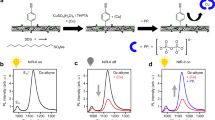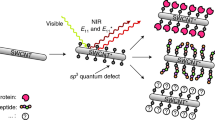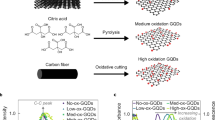Abstract
The potential of luminescent semiconductor quantum dots (QDs) to enable development of hybrid inorganic-bioreceptor sensing materials has remained largely unrealized. We report the design, formation and testing of QD–protein assemblies that function as chemical sensors. In these assemblies, multiple copies of Escherichia coli maltose-binding protein (MBP) coordinate to each QD by a C-terminal oligohistidine segment and function as sugar receptors. Sensors are self-assembled in solution in a controllable manner. In one configuration, a β-cyclodextrin-QSY9 dark quencher conjugate bound in the MBP saccharide binding site results in fluorescence resonance energy-transfer (FRET) quenching of QD photoluminescence. Added maltose displaces the β-cyclodextrin-QSY9, and QD photoluminescence increases in a systematic manner. A second maltose sensor assembly consists of QDs coupled with Cy3-labelled MBP bound to β-cyclodextrin-Cy3.5. In this case, the QD donor drives sensor function through a two-step FRET mechanism that overcomes inherent QD donor–acceptor distance limitations. Quantum dot–biomolecule assemblies constructed using these methods may facilitate development of new hybrid sensing materials.
This is a preview of subscription content, access via your institution
Access options
Subscribe to this journal
Receive 12 print issues and online access
$259.00 per year
only $21.58 per issue
Buy this article
- Purchase on Springer Link
- Instant access to full article PDF
Prices may be subject to local taxes which are calculated during checkout






Similar content being viewed by others
References
Iqbal, S.S. et al. A review of molecular recognition technologies for detection of biological threat agents. Biosens. Bioelect. 15, 549–578 ( 2000).
O'Connell, P.J. & Guilbault, G.G. Future trends in biosensor research. Anal. Lett. 34, 1063–1078 ( 2001).
De Lorimier, R.M. et al. Construction of a fluorescent biosensor family. Protein Sci. 11, 2655–2675 ( 2002).
Scheller, F.W., Wollenberger, U., Warsinke, A., & Lisdat, F. Research and development in biosensors. Curr. Opin. Biotech. 12, 35–40 ( 2001).
Hellinga, H.W. & Marvin, J.S. Protein engineering and the development of generic biosensors. Trends Biotech. 16, 183–189 ( 1998).
Benson, D.E., Conrad, D.W., de Lorimer, R.M., Trammel, S.A. & Hellinga, H.W. Design of bioelectronic interfaces by exploiting hinge-bending motions of proteins. Science 293, 1641–1644 ( 2001).
Mattoussi, H. et al. Self-Assembly of CdSE-ZnS quantum dot bioconjugates using an engineered recombinant protein. J. Am. Chem. Soc. 122, 12142–12450 ( 2000).
Bruchez, M., Moronne, J.M., Gin, P., Weiss, S. & Alivisatos, A.P. Semiconductor nanocrystals as fluorescent biological labels. Science 281, 2013–2018 ( 1998).
Chan, W.C.W. & Nie, S. Quantum dot bioconjugates for ultrasensitive nonisotopic detection. Science 281, 2016–1028 ( 1998).
Goldman, E.R. et al. Conjugation of luminescent quantum dots with antibodies using an engineered adaptor protein to provide new reagents for fluoroimmunoassays. Anal. Chem. 274, 841–847 ( 2002).
Goldman, E.R. et al. Avidin: A natural bridge for quantum dot-antibody conjugates. J. Am. Chem. Soc. 122, 6378–6382 ( 2002).
Dubertret, B. et al. In vivo imaging of quantum dots encapsulated in phospholipid micelles. Science 298, 1759–1761 ( 2002).
Jaiswal, J.K., Mattoussi, H, Mauro, J.M. & Simon, S.M. Long-term multiple color imaging of live cells using quantum dot bioconjugates. Nature Biotech. 21, 47–51 ( 2003).
Mattoussi, H, et al. in Optical Biosensors: Present and Future (eds Ligler, F.S. & Rowe Taitt, C.A.). (Elsevier, The Netherlands, 2002).
Akerman, M.E. et al. Nanocrystal targeting in vivo. Proc. Natl Acad. Sci. USA 99, 12617–12621 ( 2002).
Wu, X.Y. et al. Immunofluorescent labeling of cancer marker Her2 and other cellular targets with semiconductor quantum dots. Nature Biotech. 21, 41–46 ( 2003).
Kagan, C.R., Murray, C.B. & Bawendi, M.G. Long-range resonance transfer of electronic excitations in close-packed CdSe quantum-dot solids. Phys. Rev. B 54, 8633–8643 ( 1996).
Kagan, C.R., Murray, C.B. Nirmal, M. & Bawendi, M.G. Electronic energy transfer in CdSe quantum dot solids. Phys. Rev. Lett. 76, 1517–1520 ( 1996).
Crooker, S.A., Hollingsworth, J.A., Tretiak, S. & Klimov, V.I. Sprectrally resolved dynamics of energy transfer in quantum-dot assemblies: towards engineered energy flows in artificial materials. Phys. Rev. Lett. 89, 186802 ( 2002).
Willard, D.M., Carillo, L.L., Jung, J. & Van Orden, A. CdSe-ZnS Quntum Dots as resonance energy transfer donors in a model protein-protein binding assay. Nano Lett. 1, 469–474 ( 2001).
Wang, S., Mamedova, N, Kotov, N.A., Chem, W. & Studer, J. Antigen/antibody immunocomplex from CdTE nanoparticle bioconjugates. Nano Lett. 2, 817–822 ( 2002).
Gilardi, G., Zhou, L.Q., Hibbert, L. & Cass, A.E. Engineering the maltose binding protein for reagentless fluorescence sensing. Anal. Chem. 66, 3840–3847 ( 1994).
Marvin, J.S. et al. The rational design of allosteric interactions in a monomeric protein and its applications to the construction of biosensors. Proc. Natl Acad. Sci. USA 94, 4366–4371 ( 1997).
Fehr, M., Frommer, W.B. & Lalonde, S. Visualization of maltose uptake in living yeast cells by fluorescent nanosensors. Proc. Natl Acad. Sci. USA 99, 9846–9851 ( 2002).
Medintz, I.L., Goldman, E.R., Lassman, M.E. & Mauro, J.M. A fluorescence resonance energy transfer sensor based on maltose binding protein. Bioconj. Chem. (in the press).
Lakowicz, J.R. Principles of Fluorescence Spectroscopy 2nd edn (Kluwer Academic, New York, 1999).
Flora, B., Gusman, H., Helmerhorst, E.J., Troxler, R.F. & Oppenheim, F.G. A new method for the isolation of histatins 1, 3, and 5 from parotid secretion using zinc precipitation. Protein Expr. Purif. 23, 198–206 ( 2001).
Mamedova, N.N., Kotov, N.A., Rogach, A.L. & Studer, J. Albumin-CdTe nanoparticle bioconjugates: preparation, structure, and interunit energy transfer with antenna effect. Nano Lett. 1, 281–286 ( 2001).
Wang, L.Y., Kan, X.W., Zhang, M.C., Zhu, C.Q. & Wang, L. Fluorescence for the determination of protein with functionalized nano-ZnS. The Analyst 127, 1531–1534 ( 2002).
Hanaki, K. et al. Semiconductor quantum dot/albumin complex is a long-life and highly photostable endosome marker. Biochem. Biophys. Res. Comm. 302, 496–501 ( 2003).
Sharff, A.J., Rodseth, L.E. & Quicho, F.A. Refined 1.8 Å structure reveals the mode of binding of β–cyclodextrin to the maltodextrin binding protein. Biochemistry 32, 10553–10559 ( 1993).
Kawahara, S., Uchimaru, T. & Murata, S. Sequential multistep energy transfer: enhancement of efficiency of long-range fluorescence resonance energy transfer. Communication 6, 563–564 ( 1999).
Tong, A.K., Li, Z., Jones, G.S., Russon, J.J. & Ju, J. Combinatorial fluorescence energy transfer tags for multiplex biological assays. Nature Biotech. 19, 756–759 ( 2001).
Guether, R. & Reddington, M.V. Photostable cyanine dye β-cyclodextrin conjugates. Tetrahedr. Lett. 38, 6167–6170 ( 1997).
Watrob, H.M., Pan, C.P. & Barkley, M.D. Two-step FRET as a structural tool. J. Am. Chem. Soc. 125, 7336–7343 ( 2003).
Schafer, F. et al. Automated high-throughput purification of 6XHis-tagged proteins. J. Biomol. Tech. 13, 131–137 ( 2002).
Pathak, S. et al. Hydroxylated quantum dots as luminescent probes for in situ hybridization. J. Am. Chem. Soc. 123, 4103–4104 ( 2001).
Gerion, D. et al. Sorting fluorescent nanocrystals with DNA. J. Am. Chem. Soc. 124, 7070–7074 ( 2002).
Guo, W., Li, J.J., Wang, Y.A. & Peng, X. Luminescent CdSe/CdS core/shell nanocrystals in dendron boxes:superior chemical, photochemical and thermal stability J. Am. Chem. Soc. 125, 3901–3909 ( 2003).
Willner, I., Patolsky, F. & Wasserman, J. Photoelectrochemistry with controlled DNA-cross-linked CdS nanoparticle arrays. Angew. Chem. Int. Edn Engl. 40, 1861–1864 ( 2001).
Lindsey, C.P. & Pattersson, G.D. Detailed comparison of the Williams-Watts and Cole-Davidson functions. J. Chem. Phys. 73, 3348–3357 ( 1980).
Acknowledgements
The authors thank H. Hellinga and D. Conrad (Duke University) for providing the plasmid with the MBP-HIS-tagged gene sequence used and P.T. Tran for helpful insight. I.L.M. and A.R.C. are supported by National Research Council Fellowships through the Naval Research Laboratory. B.F. acknowledges the National Defense Science and Engineering Graduate Fellowship Program for support. H.M., E.R.G. and J.M.M acknowledge K. Ward at the Office of Naval Research (ONR) for research support and grant number N001400WX20094 for financial support. The views, opinions, and/or findings described in this report are those of the authors and should not be construed as official Department of the Navy positions, policies, or decisions.
Author information
Authors and Affiliations
Corresponding authors
Ethics declarations
Competing interests
The authors declare no competing financial interests.
Supplementary information
Rights and permissions
About this article
Cite this article
Medintz, I., Clapp, A., Mattoussi, H. et al. Self-assembled nanoscale biosensors based on quantum dot FRET donors. Nature Mater 2, 630–638 (2003). https://doi.org/10.1038/nmat961
Received:
Accepted:
Published:
Issue Date:
DOI: https://doi.org/10.1038/nmat961
This article is cited by
-
Rational Design of Capping Ligands of Quantum Dots for Biosensing
Chemical Research in Chinese Universities (2024)
-
Experimental evidence of Förster energy transfer enhancement in the near field through engineered metamaterial surface waves
Communications Physics (2023)
-
Recent advances in room-temperature phosphorescent materials by manipulating intermolecular interactions
Science China Chemistry (2023)
-
Quantum Dot Nanomaterials: Preparation, Characterization, Advanced Bio-Imaging and Therapeutic Applications
Journal of Fluorescence (2023)
-
Affinity biosensors developed with quantum dots in microfluidic systems
Emergent Materials (2021)



